Poster Day 2017
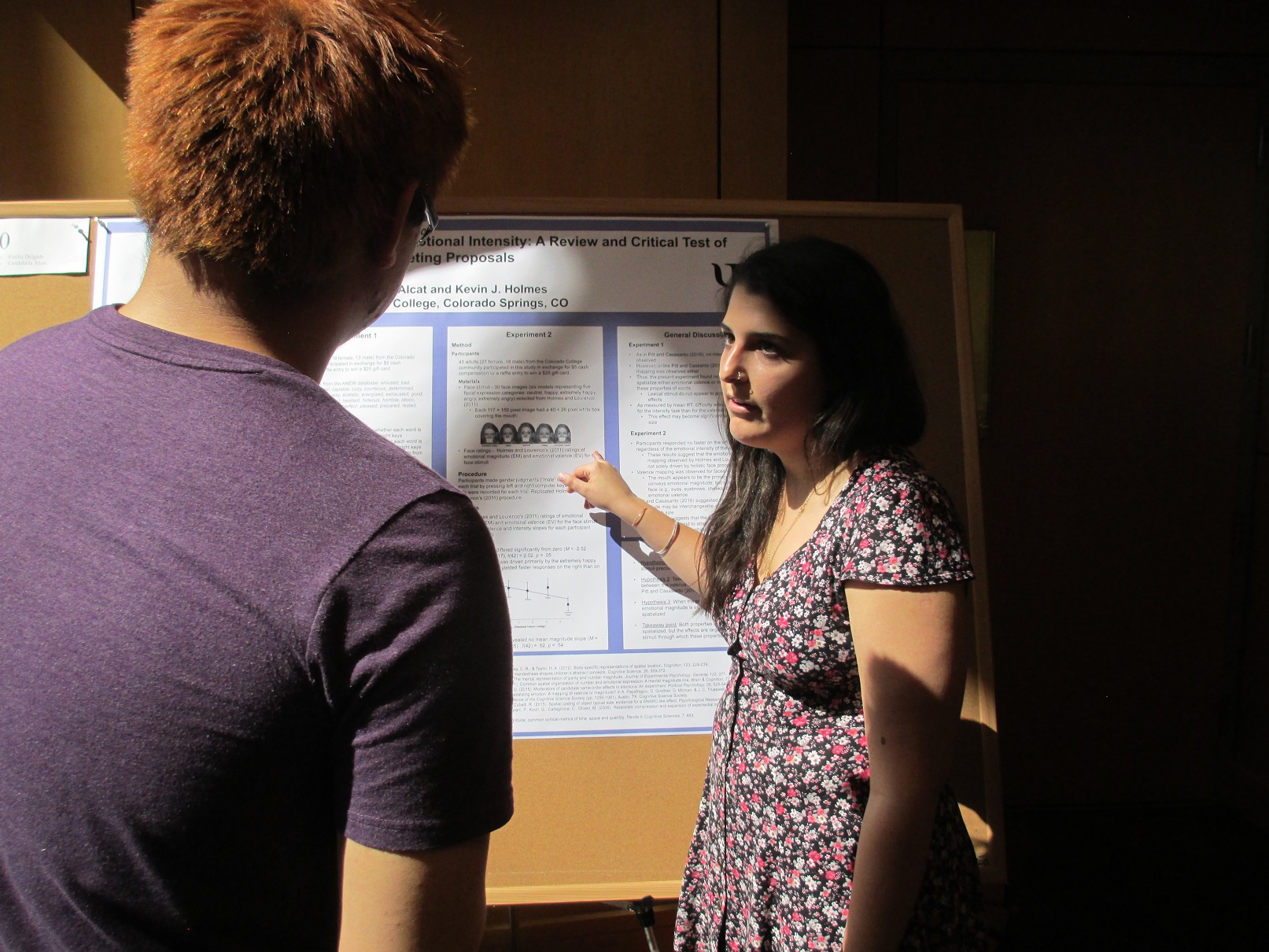 Candelaria Alcat
Candelaria Alcat
Psychology
Advisor: Kevin Holmes
Spatializing Emotional Valence and Emotional Intensity: A Review and Critical Test of
Competing Proposals
Abstract: Research has shown that people tend to spatialize the concept of valence, associating the left side of space with negative valence and the right side of space with positive valence. Other research has shown that people tend to spatialize the concept of magnitude, associating the left side of space with smaller values and the right side of space with larger values, irrespective of valence. Although both left-to-right mappings of emotional concept exist, these two mappings may conflict. Experiment 1 investigated spatial effects when participants were presented with lexical stimuli and asked to make speeded judgments on either the emotional valence or intensity of a word. Experiment 2 investigated similar effects when participants were presented with facial stimuli and asked to make speeded gender judgments. The present findings suggest that lexical stimuli precludes the possibility of finding spatial effects and, thus, looked to facial stimuli to reconcile the conflicting findings. Results from Experiment 2 suggest that, for facial stimuli, valence trumps magnitude when the mouth is covered; previous research suggests that magnitude trumps valence when the mouth is present. The present study concludes that both properties of emotion can be spatialized, but that the effects are largely dependent on the stimuli through which these properties are conveyed.
Jenny Chandler
Psychology
Advisor: Tricia Waters
Social-Cognitive Interventions for Children
with Autism Spectrum Disorder
This paper examines social-emotional behavioral interventions for children with Autism Spectrum Disorder (ASD). Competing cognitive theories of ASD are discussed and applied to three prominent intervention models: 1) the UCLA Lovaas model, 2) the Early Start Denver model (ESDM), and 3) Social Skills Training. The review of literature on behavioral intervention for ASD is used to contextualize an individual case-study conducted by the author, in which a behavioral intervention program is applied to two children with ASD and an intellectual deficiency. The behavioral intervention is evaluated and future treatment courses are suggested.
 Cassandra Cohen
Cassandra Cohen
Psychology
Advisor: Kristi Erdal
Potential for Stereotype Lift of Creativity in
Individuals Diagnosed with Bipolar Disorder
There is much fascination surrounding the neural and psychological aspects behind highly creative individuals. A collection of research supports the link between bipolar disorder and creativity, building on anecdotal accounts of "mad artists" suffering from mental illness. Considered in this literature review are various approaches to the operationalization of creativity as well as the positive associations between these measurement scales and individuals experiencing hypomania, mania, or even hypomania risk, when compared to healthy controls. Evidence for frontal lobe underactivation being involved in creative success as well as all mood states within bipolar disorder provides further evidence for the link. The potential for a stereotype lift within individuals diagnosed with bipolar disorder exists, one which could be part of a new positive dialogue in the fight against mental illness stigma.
 Brigid Connelly
Brigid Connelly
Psychology
Advisor: Tomi-Ann Roberts
"I Woke Up Like This"
System Justification, Terror Management, and Self-Objectification in a Social Media World
This study examined two competing theories for the sexual objectification of women and women's self-objectification in the context of social media. We explored the extent to which terror management and system justification influenced participants' emotional responses to a manipulated Instagram post featuring a model in a bikini. In a 2x2 design, participants completed a self-objectification measure before being shown one of two Instagram photographs (with and without pubic hair visible), to activate a terror management response, and featuring one of two captions (with and without a feminist message about the unhealthy and unrealistic standards behind a "curated" social media photo), to activate a system justification response. Following the photograph and caption manipulation, participants' general mood and affect was measured. Overall, those participants with higher levels of self-objectification reported feeling more hostility and more general negative affect overall after reading the feminist message compared to participants with low levels of self-objectification. In addition, older participants in the existential photograph condition reported higher levels of hostility and disgust compared to younger participants in the same condition or participants in either of the caption conditions. These findings give strong support for system justification theory as an explanation for the sexual objectification of women as well as self-objectification.
 Emilia Lynn Delgado Heinz
Emilia Lynn Delgado Heinz
Psychology
Advisor: John Horner
"How Bad Was It?"
Situational Factors Determining the
Perceived Seriousness of Rape
The traditional narrative of rape, a male stranger attacking an unsuspecting woman, is not the only or most common way in which rape occurs. However, because this is the commonly assumed narrative, other forms of rape that are less representative may be devalued and seen as less serious crimes. This study investigated whether representativeness of specific rape scenarios affect perceptions of crime seriousness varying situational factors. Results showed that the situational factors of perpetrator-victim relationship status and perpetrator-victim gender pairing combinations both significantly affect perceptions of rape seriousness. Rapes were seen as more serious when the perpetrator and victim had a more distant relationship. All perpetrator-victim gender pairings were seen as equally serious, except for the female to male rape condition. This condition was perceived as significantly less serious.
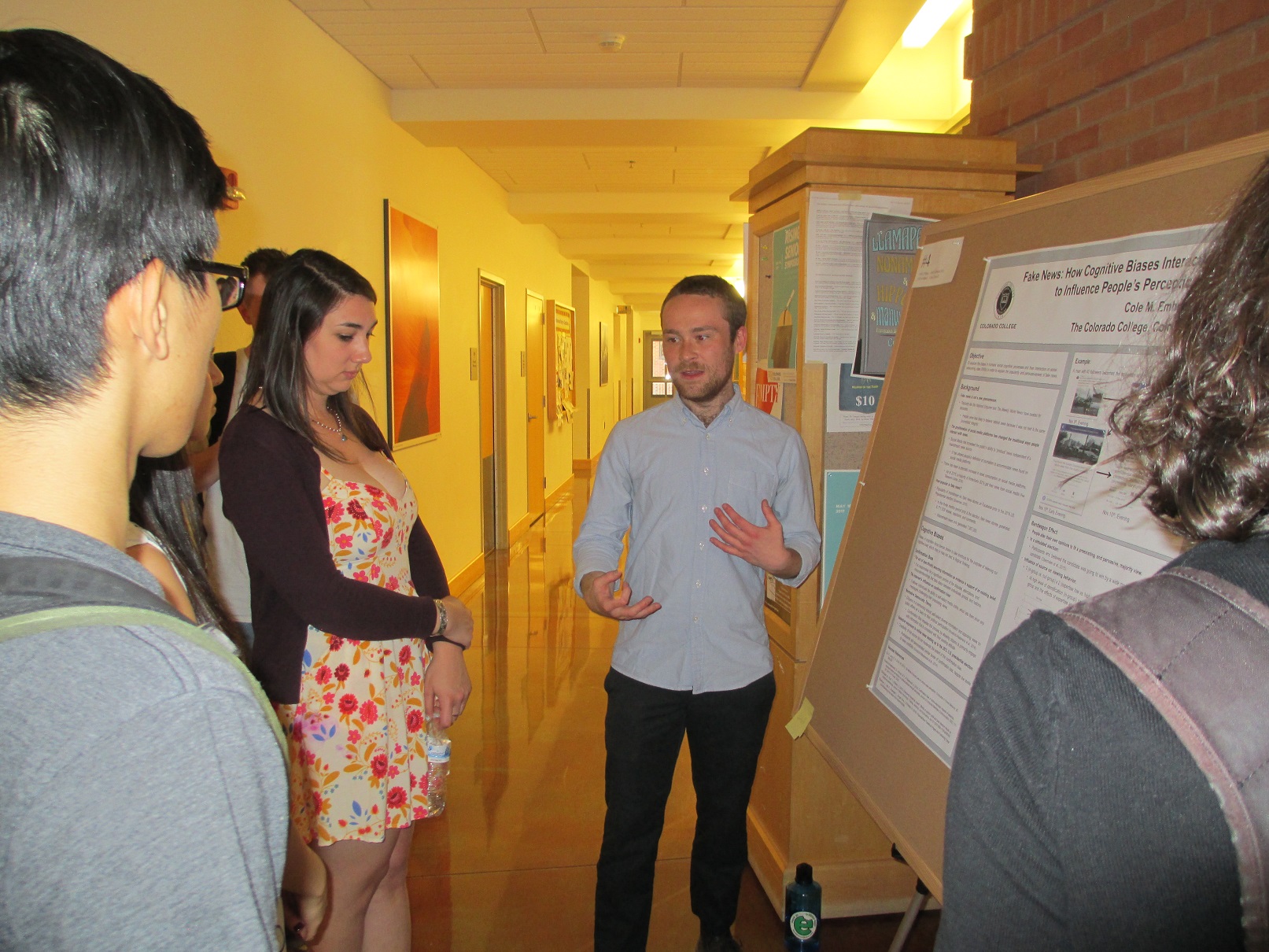 Cole M. Emhoff
Cole M. Emhoff
Psychology
Advisor: Kristi Erdal
Fake News: How Cognitive Biases Interact
with Social Networking Sites to Influence
People's Perception of Misinformation
The purpose of this literature review is to investigate the biases in humans' social cognitive processes and their interaction on social networking sites (SNSs) in order to explain the popularity and persuasiveness of fake news. A review of the background information associated with fake news suggested that, while fake news is not a new phenomenon, it has experienced an increase in popularity, which incentivized its increased pervasiveness. Attention is then turned to the biases in cognition that force human brains to take a variety of different shortcuts for the purpose of relieving cognitive load. Finally, it is argued that specific elements of SNSs, like a Facebook "like" may exacerbate theses cognitive biases.
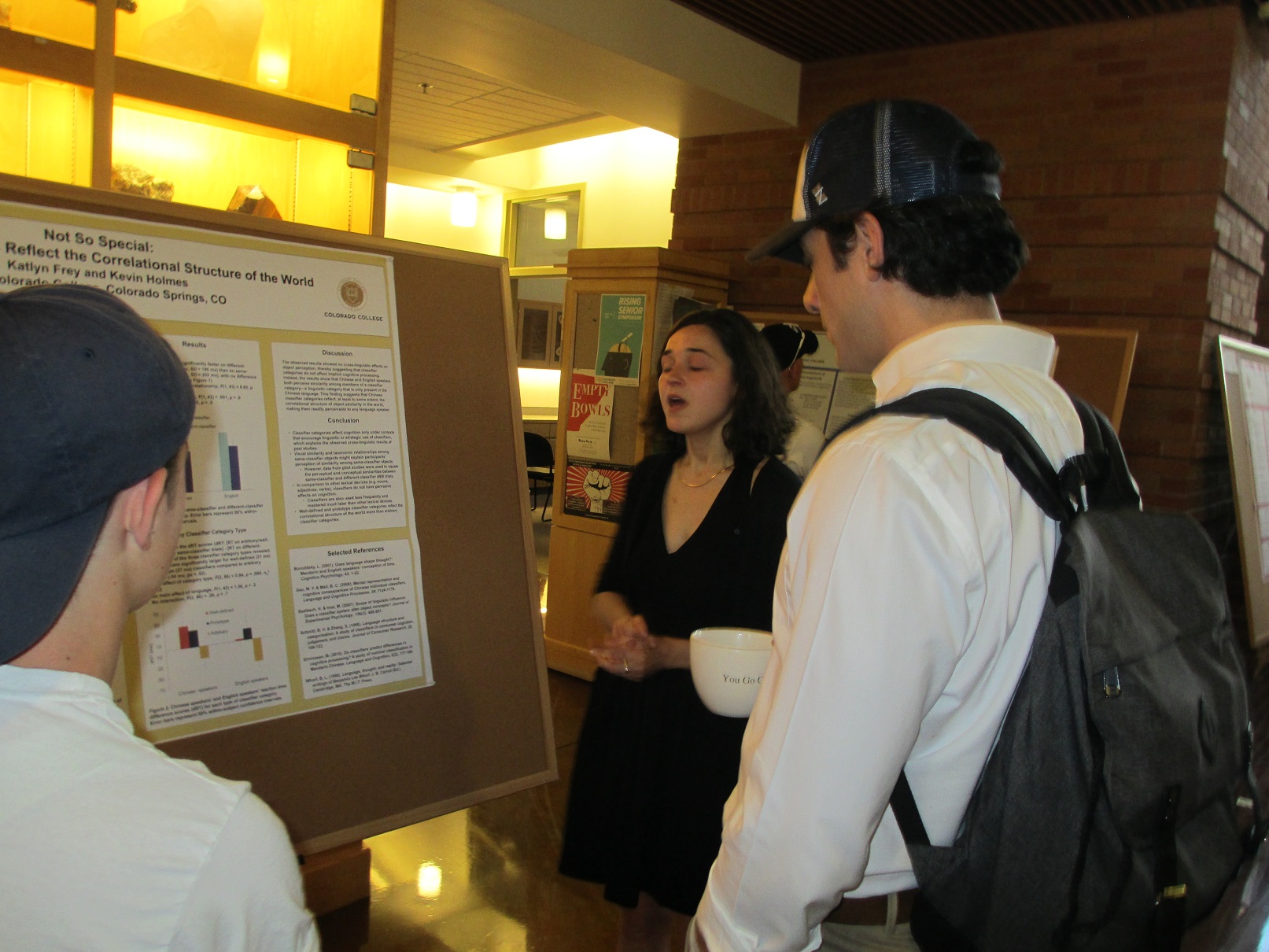 Katlyn Frey
Katlyn Frey
Psychology
Advisor: Kevin Holmes
Not So Special: Classifier Categories Reflect the
Correlational Structure of the World
According to the Whorfian hypothesis, linguistic categories affect cognition. Because Chinese, but not English, possesses a system of classifier categories associated with nouns, such categories provide an opportunity to test the Whorfian hypothesis. Consistent with this hypothesis, previous research using explicit measures suggests that Chinese speakers are more aware of similarities among same-classifier objects than different-classifier objects, but that English speakers are not. The purpose of the current study was to determine whether the Whorfian findings of previous research were driven by these explicit experimental contexts. I found that, when the experimental task was made implicit, Chinese and English speakers attended equally to similarities between same-classifier objects. This absence of a cross-linguistic effect on implicit cognitive processing indicates that the effects of classifier categories may be rather modest. Instead, the results suggest a world-on-thought effect, whereby Chinese and English speakers are equally sensitive to the correlational structure of the world, with classifier categories reflecting that structure.
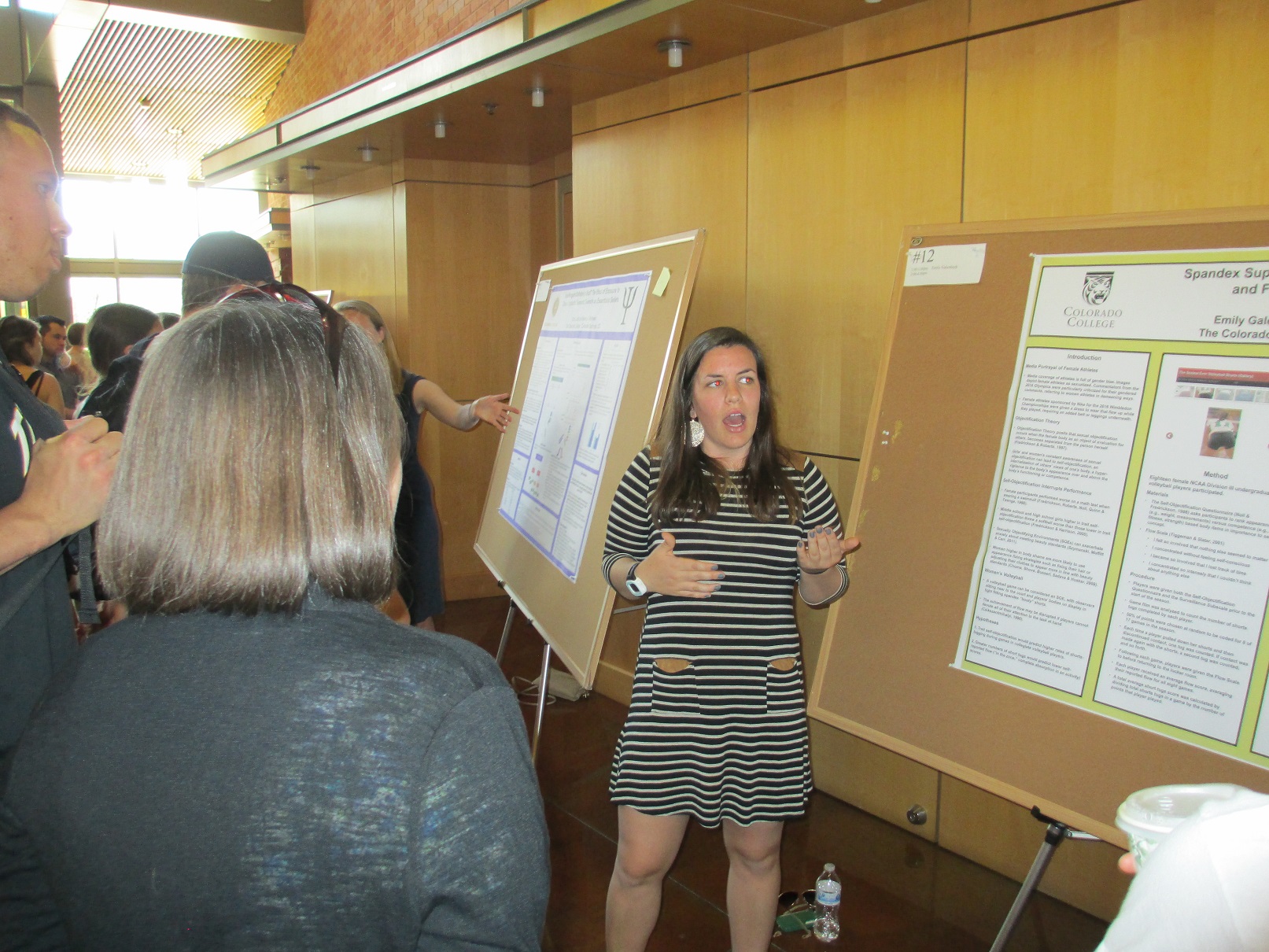 Emily Galenbeck
Emily Galenbeck
Psychology
Advisor: Tomi-Ann Roberts
Spandex Superstition:
Uniform Adjustments and Flow in Volleyball Players
Self-objectification, derived from Objectification Theory (Fredrickson & Roberts, 1997), posits that women develop a separation between their body and themselves due to unrealistic standards of attractiveness for the female body. Self-objectification predicts increases in negative emotions and decreases in positive states, like flow. A women's volleyball game has many observers and revealing uniforms, making it a prime environment for the experience of self-objectification. In the present study, uniform adjustments of 18 female collegiate volleyball players were observed. Results showed that players who were high in trait self-objectification reported higher flow scores after tugging their shorts more times during games. Players who were low in trait self-objectification did not show this relationship. Based on the raw game footage, short tugs appeared to be superstitious, as they were performed in a repetitive, habitual manner and only between points. These findings suggest that the spandex "booty shorts" customarily worn by female volleyball players are distracting for them. Players themselves appear to engage in "spandex superstition" as a way of boosting their performance.
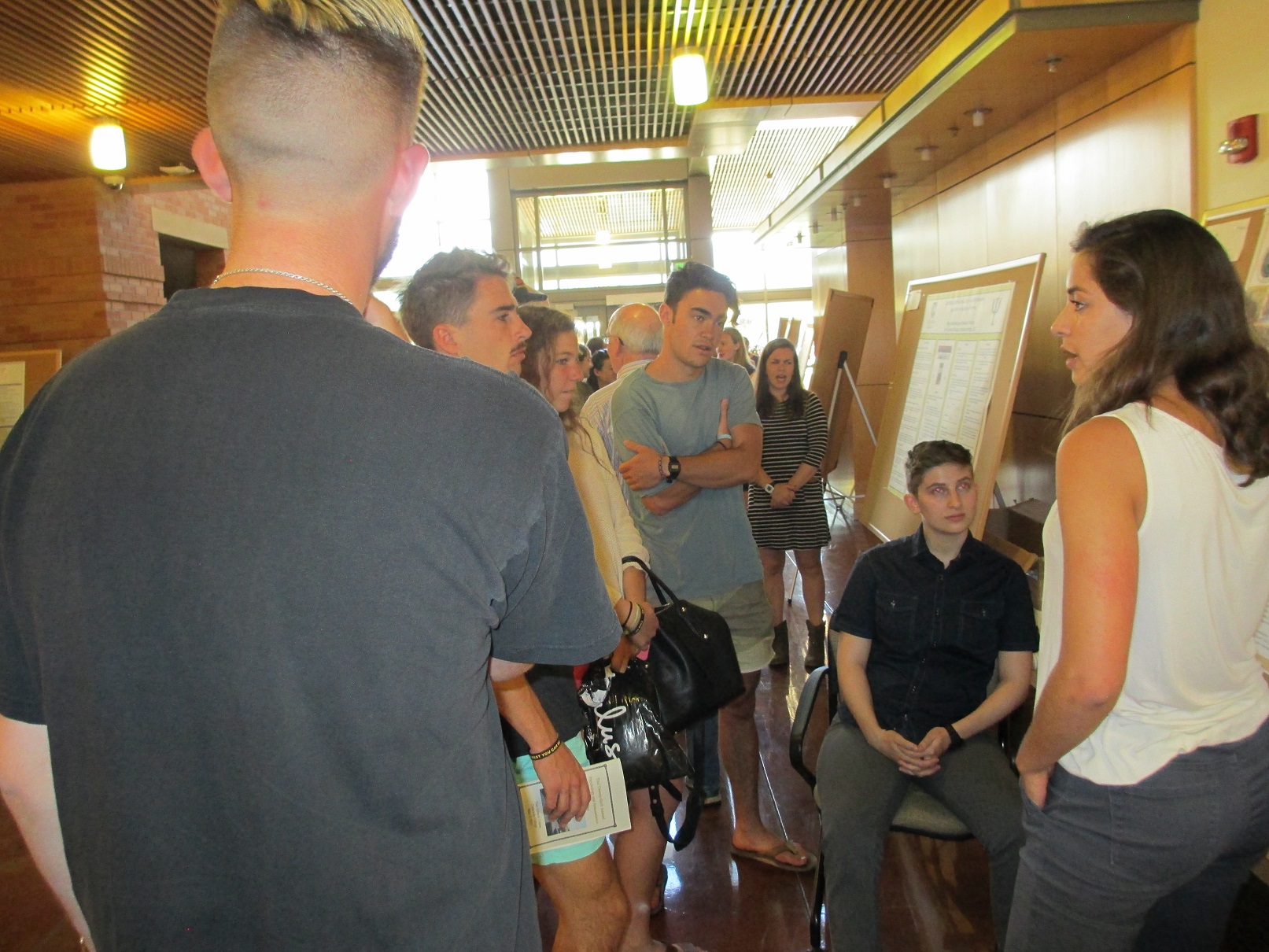 Madeleine Garcia & Beckett Shea-Shumsky
Madeleine Garcia & Beckett Shea-Shumsky
Neuroscience & Psychology
Advisor: Bob Jacobs
Comparative Neuronal Morphology of
Gigantopyramidal Neurons in Mammals
Although the basic morphological characteristics of gigantopyramidal (Betz) neurons have been documented in a limited number of species, the quantitative characteristics of these neurons across different taxa remain unexplored. To this end, the present study qualitatively and quantitatively investigated gigantopyramidal neurons in the primary motor cortices of 19 different species across eight phylogenetic taxa: feliforms (caracal, clouded leopard, lion, mongoose, Siberian tiger), primates (baboon, golden tamarin, human, lemur), artiodactyls (blue wildebeest, giraffe, kudu), caniforms (African wild dog, domestic dog), perissodactyls (mountain zebra, plains zebra), a diprotodont (wallaby), a lagomorph (rabbit), and a rodent (rat). For comparative purposes, three types of pyramidal neurons (i.e., superficial pyramidal, deep pyramidal, and gigantopyramidal; N= 617) were stained with a modified rapid Golgi technique and quantified on a computer-assisted microscopy system. Qualitatively, gigantopyramidal neurons varied considerably among species. Compared to other taxa, perissodactyls and artiodactyls demonstrated widely bifurcating V-shaped apical dendrites. Quantitatively, gigantopyramidal neurons were substantially larger than deep and superficial pyramidal neurons and exhibited more numerous primary basilar dendrites extending circumferentially from the soma. Feliforms exhibited the largest gigantopyramidal neurons, particularly of genus Panthera, consistent with Brodmann's (1909) observation of exceptionally large gigantopyramidal neurons in carnivores. As these neurons are thought modulate downstream motor output, their comparatively large size in feliforms may be due to the enhanced synchronization of muscle movements (i.e. pouncing behavior) demonstrated by species in this taxa.
 Annie Hale
Annie Hale
Psychology
Advisor: Jason Weaver
An Investigation of 2d:4d Ratios in
Relation to Sexual Orientation:
Application of a New Sexual Orientation Measure
The ratio of the hand's second digit, 2d, to the fourth digit, 4d, has been studied as a biological indicator of prenatal exposure to testosterone and estrogen. The 2d:4d ratio has been shown to have a positive correlation with attraction to men and a negative correlation with attraction to women. However, some attempts to replicate such correlations have been unsuccessful. By introducing a new methodology, the Multidimensional Measure of Sexual Orientation (MMSO), I hypothesized that clearer correlations between 2d:4d and sexual orientation would occur. Results were inconclusive and warrant further study, but indicate the MMSO as promising in regards to reliability, construct validity, and use as a methodology for 2d:4d research.
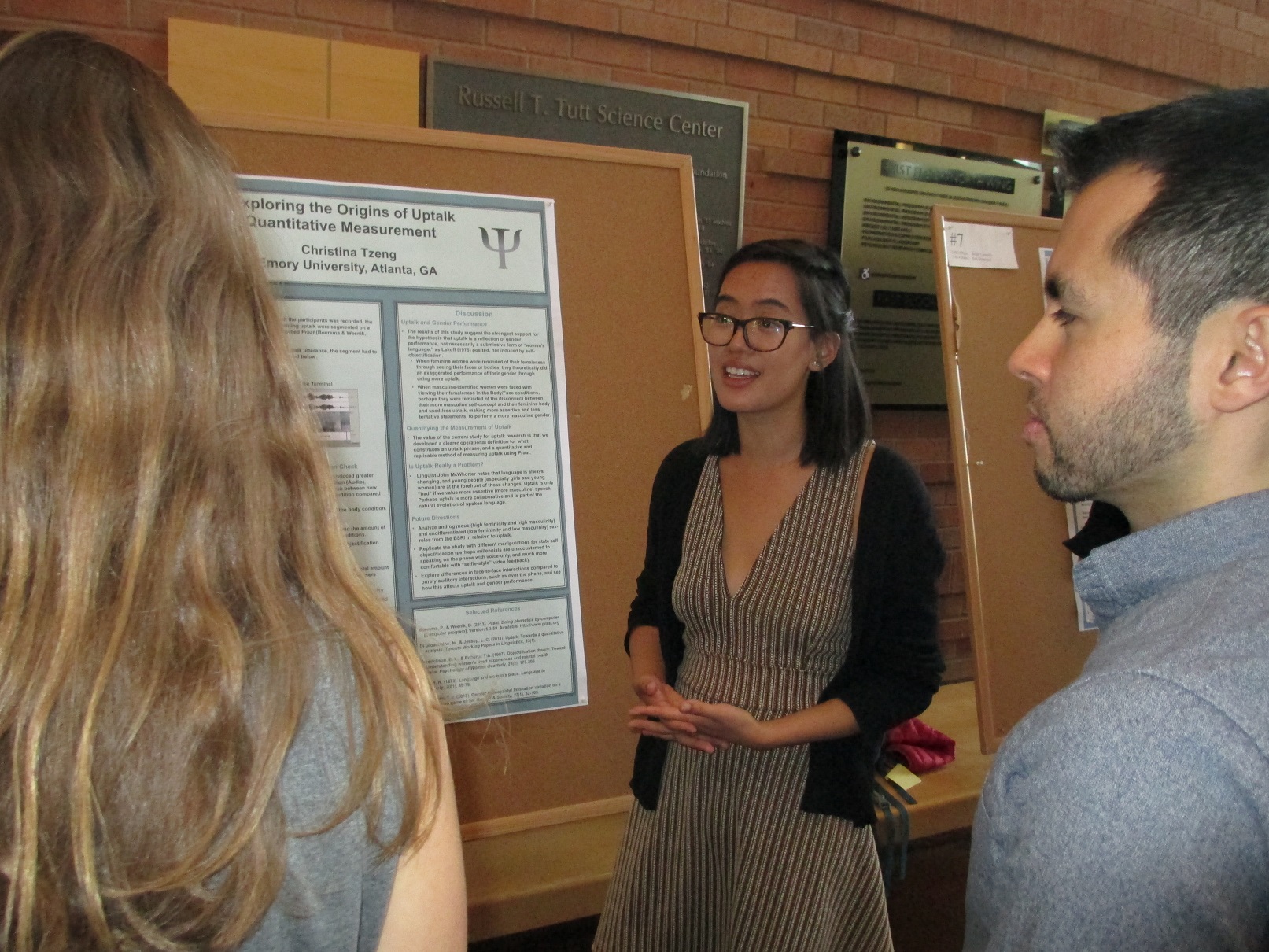 Regina Marie Dominique Reyes Henares
Regina Marie Dominique Reyes Henares
Psychology
Advisor: Tomi-Ann Roberts
"I am a Strong, Independent Woman?"
Exploring the Origins of Uptalk and Working Towards
a Standardized Quantitative Measurement
Uptalk is a speech pattern used predominantly by women where declarative statements end with a rising intonation. The current study aimed to explore the following three theories for the origins of uptalk. Firstly, the study explored Lakoff's (1975) theory that women use uptalk to situate themselves as subservient to men, which was tested by measuring whether participants used more uptalk when they were led to believe that they were interacting with a man versus a woman. Secondly, Linneman's (2013) theory that uptalk is a way to perform gender was tested by measuring femininity and masculinity and observing if there were opposing patterns of uptalk for feminine and masculine women. Finally, the study tested whether uptalk occurred as a consequence of self-objectification (Fredrickson & Roberts, 1997) by measuring the amount of uptalk used by the participants when a camera was pointed at either their body or face, and when the camera lens was covered and only an audio recording was taken. The main finding supported Linneman's theory of gender performance; feminine women used significantly more uptalk than masculine women when a camera was pointed at their face or body, while the inverse effect was found when participants only had their voices recorded. Furthermore, the study aimed to standardize and simplify the procedure for identifying and measuring uptalk.
 Jacob Jones
Jacob Jones
Psychology
Advisor: Tomi-Ann Roberts
Exploring AU 13:
An Analysis of Smile Type, Gender, and Facial First Impressions
AU 13, also known as the cheek puffer, is a smile type that involves contracting the muscles that run vertically from just above the canine teeth to the cheek bone just below the eye. This smile involves a steeper upturning of the corners of the mouth than AU 12, involved in the Duchenne smile, which pulls the corners of the mouth more horizontally (Ekman, Friesen, & Hager, 2002). Research suggests that women are expected to smile more than men, and so may deploy a greater variety of smile types. The present studies examined the relationship between these smile types and gender. A broad approach was taken in study 1 to explore first impressions of these smile types on male and female faces. AU 12 was perceived by both genders as significantly more trustworthy, attractive, warm, friendly, and happy than AU 13, whether on a male or a female face. Generally, however, AU 13 displayed on a female face was described with a greater variety of first impressions than on a male face, and a female displaying AU 13 was viewed as significantly less competent than when displaying AU 12. In study 2, AU 13 was found to be perceived as reflecting significantly less positive and significantly more negative emotions than AU 12, regardless of whether appearing on a male or female face. Implications and directions for future research are discussed.
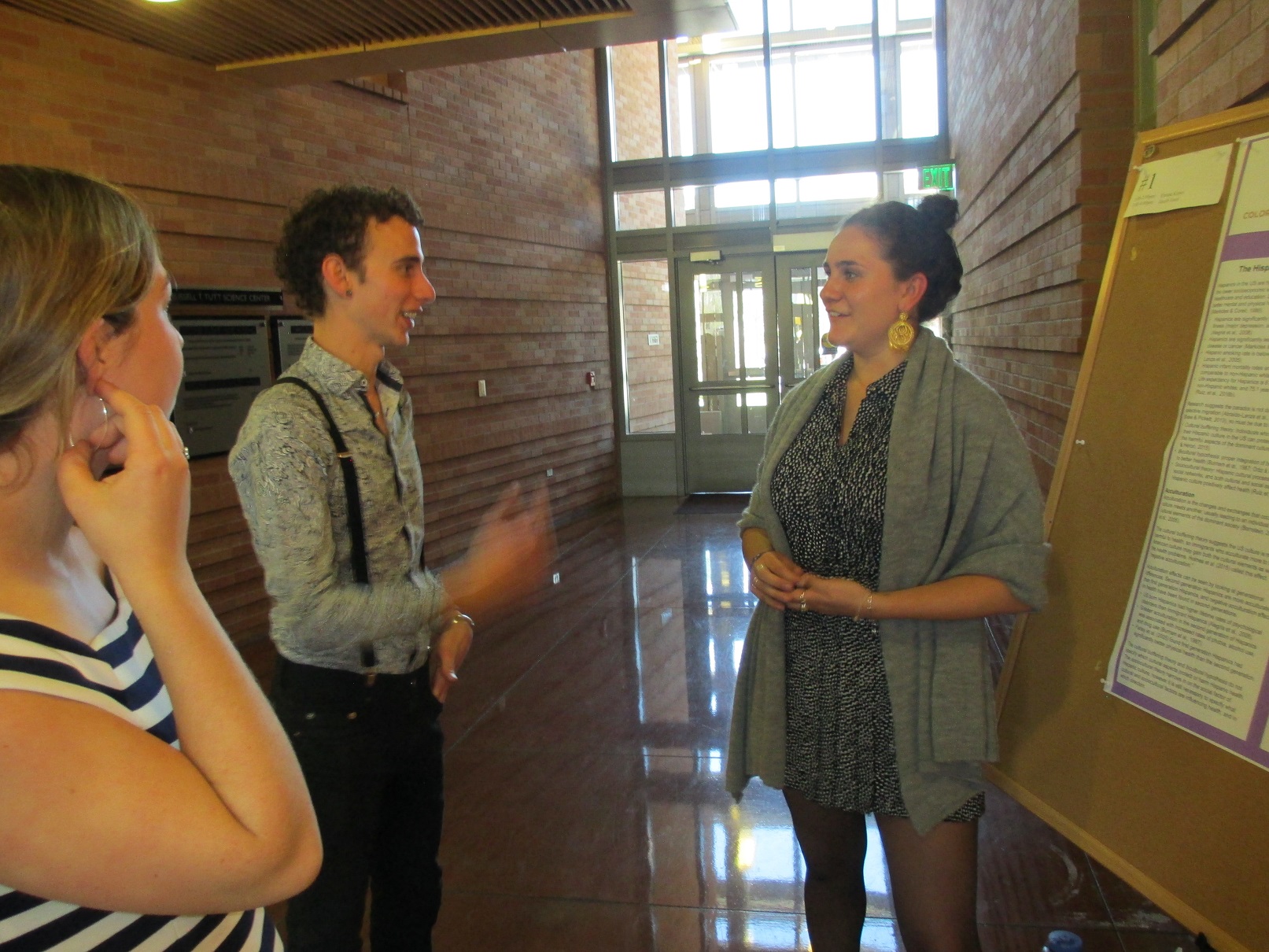 Emma Kepes
Emma Kepes
Psychology
Advisor: John Horner
Explaining the Hispanic Health Paradox
This paper reviews current literature on the Hispanic Health Paradox to further define the mechanisms behind why Hispanics have better mental and physical health than other ethnic groups in the US. Research on stress management, language use, diet and activity level, as well as social aspects were reviewed in order to determine which cultural factors are most advantageous for Hispanic health. This research suggest that Hispanics have cultural habits and behaviors that give them a health advantage, but that the advantage decreases as Hispanics acculturate and adopt more American behaviors and habits. Three theories have been suggested to explain the paradox, and this paper shows how each has merits when looking at different cultural factors. However, the sociocultural theory is more complete in defining how Hispanic social practices are the key component leading to the paradox.
 Eileen Kitrick
Eileen Kitrick
Psychology
Advisor: Jason Weaver
Fluid Multiracial Identity Maintenance
Through Speech Style Variation
Speech styles specific to racial groups index identity and perception as they relate to group stereotypes. Flexibility in enhancing and diminishing racially-marked speech styles by multiracial individuals maps on to individuals' racial flexibility. Through the lens of social identity theory and communication accommodation theory, language affects permeability of social boundaries and the communication consequences that ensue. For people who hold multiple racial identities, speech style defines relationships more prominently than other relevant cues. Group identification and language use cue each other reciprocally, which supports how multiracial individuals strengthen conflicting identities separately such that one may not necessarily hold a constant blended identity. As linguistic and social boundaries reinforce each other, one's language use affects perception by others and self-perception, which then influences how the individual perceives others as either racially in-group or out-group.
 Erin Luby
Erin Luby
Psychology
Advisor: Kevin Holmes
Is a Penguin Definitely a Bird?
The Effect of Exposure to Cross-Linguistic
Semantic Diversity on Essentialist Beliefs
Many people believe that certain discontinuities in the distribution of properties in the world hold true universally, such as green and blue, walk and run, and hand and arm. However, languages differ in how they carve up the world by name, and therefore, these seemingly universal discontinuities are challenged. Additionally, it has been found that certain categories, namely animals, are judged to have essentialist structure, in terms of absolute membership or objective criteria (Kalish, 2002). Essentialism is the idea that people mentally represent categories as having an underlying "essence" that makes their members what they are (Gelman, 2003; Kalish, 2002; Prentice & Miller, 2007). If people gain exposure to the cross-linguistic semantic diversity that exists, their other essentialist, all-or-none beliefs could be challenged as well. In the present study, participants who were exposed to examples of cross-linguistic semantic diversity were less likely to hold essentialist beliefs about animal categories than participants who were exposed to cross-linguistic semantic similarities or to neither similarities nor differences. This effect could potentially extend to other highly essentialized categories, such as race and gender, and could be utilized as a tool for reducing prejudice and leading people to hold less rigid beliefs about the world.
 Lindsay Miller
Lindsay Miller
Psychology
Advisor: Jason Weaver
Social Norms and the Tragedy of the Commons
Climate change mirrors many aspects of the tragedy of the commons. From excessive pollution to overuse of natural resources, people are exploiting the environment faster than it can recover. This study tested whether social norms could encourage cooperative behavior in a fabricated commons environment. Participants were instructed to complete an image-sorting task, with the cover story that the task would be completed in groups of up to 30 people. Both injunctive and descriptive norms were introduced throughout the survey to encourage conformity to group norms. Although pro-social norms did not reduce the amount of time that it took participants to complete the task, an exploratory analysis revealed that the participants who believed that they were completing the survey slower than their fictitious group took fewer breaks throughout the survey, therefore ostensibly resisting the temptation towards social loafing. Future research should establish whether these effects remain without the limitations of alpha inflation. If social norms can reduce social loafing, then they may be a cost-effective way to increase sustainable behaviors.
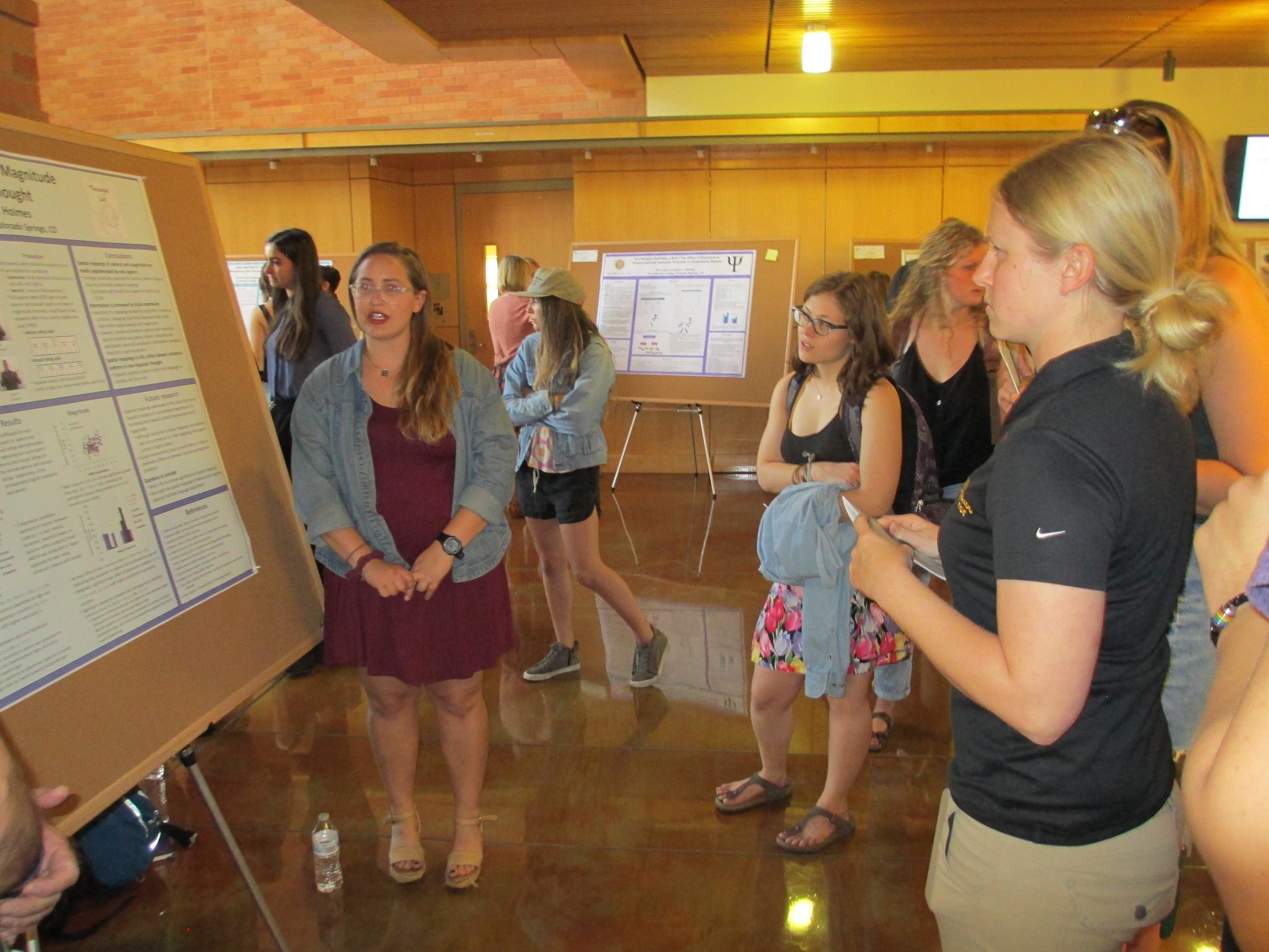 Ruth A. Rabinovitch
Ruth A. Rabinovitch
Psychology
Advisor: Kevin Holmes
Spatial Mappings of Valence and Magnitude
Extend to Nonlinguistic Thought
People often talk about abstract concepts such as valence (i.e., positive versus negative) and magnitude (i.e., more versus less) using spatial language. Spatial mappings of valence and magnitude are also reflected in the very forms of words in both spoken and signed languages. Based on the common notion that language is a window into the mind, the present study used a cross-linguistic approach to investigate whether spatial mappings previously documented in language extend to nonlinguistic cognition. Native English-speaking non-signers were presented with various American Sign Language (ASL) signs that exhibited vertical, horizontal, inward/outward, or no overall movement and were asked to judge the likely valence and magnitude of the signs' meanings. To disentangle the information regarding valence and magnitude conveyed by sign movement from that conveyed by facial expression, participants were assigned to expressive and neutral conditions. Spatial mappings of valence and magnitude were indeed readily apprehended by non-signers even in the neutral condition, suggesting that these mappings reflect deeper, perhaps universal conceptual patterns in nonlinguistic cognition. Given this evidence for the nonlinguistic reality of spatial valence and magnitude mappings, further investigation should be devoted to examining how such patterns might facilitate language acquisition.
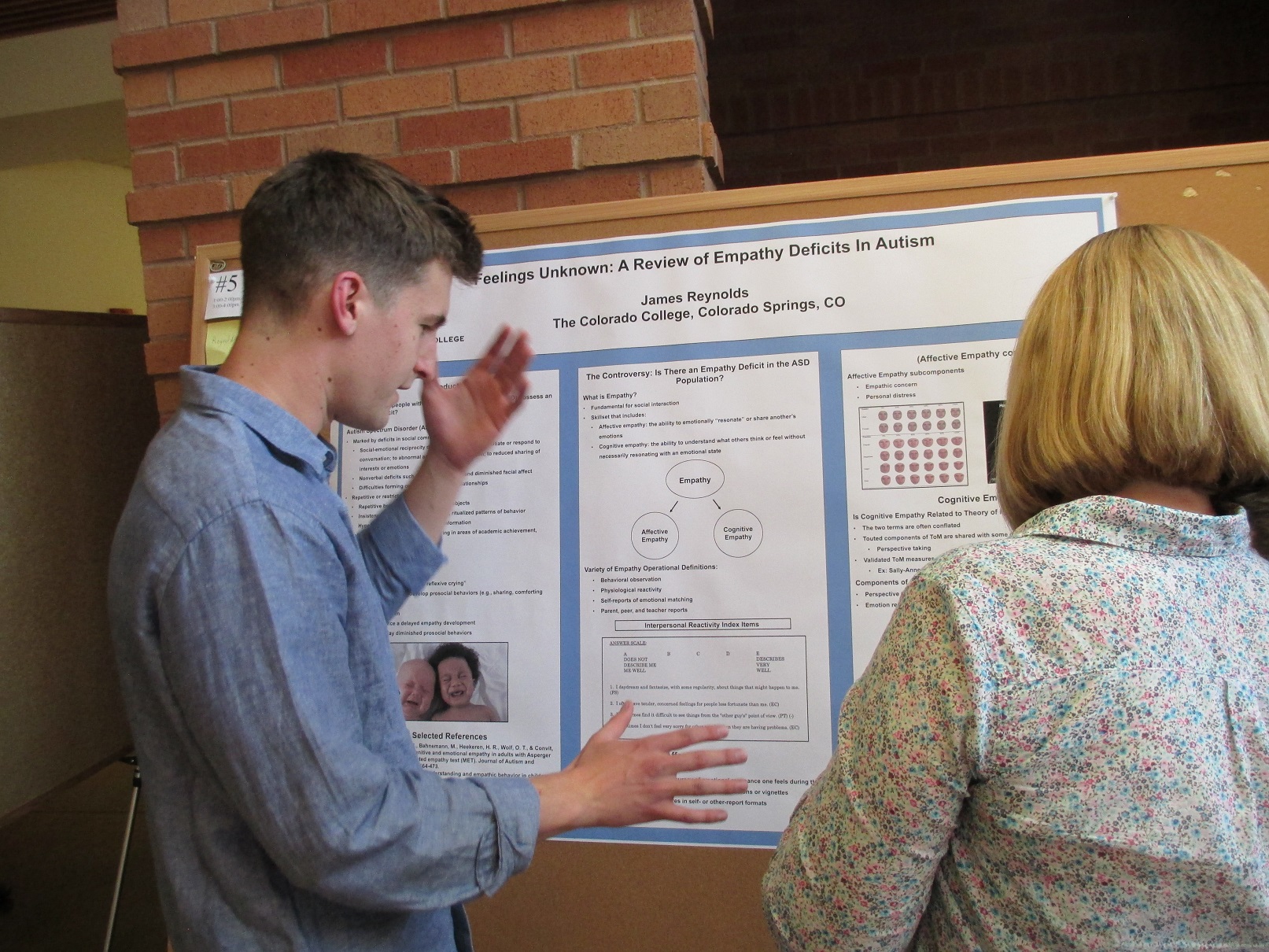 James Reynolds
James Reynolds
Psychology
Advisor: Tricia Waters
Feelings Unknown:
A Review of Empathy Deficits in Autism
Autism Spectrum Disorder (ASD) is characterized by social impairments and deficits in empathic processing. There is controversy surrounding whether people with autism suffer from a general empathy deficit, or experience specific difficulties in either its cognitive or affective component. Furthermore, research on the role of theory of mind (ToM) in empathic processing is inconsistent, with some findings suggesting that cognitive empathy is synonymous with theory of mind and other findings suggesting that the two are unrelated. A key commonality in the empathy literature, however, is the widespread use of self- and other-report questionnaires. Yet, questionnaires and other measures of empathy often lack ecological validity, and probe cognitive skills (e.g, abstract reasoning, introspection) that may confound test validity. Future directions for research include the creation and further implementation of measures that use ecologically valid stimuli, as well as a standardized assessment and operationalization of empathy constructs.
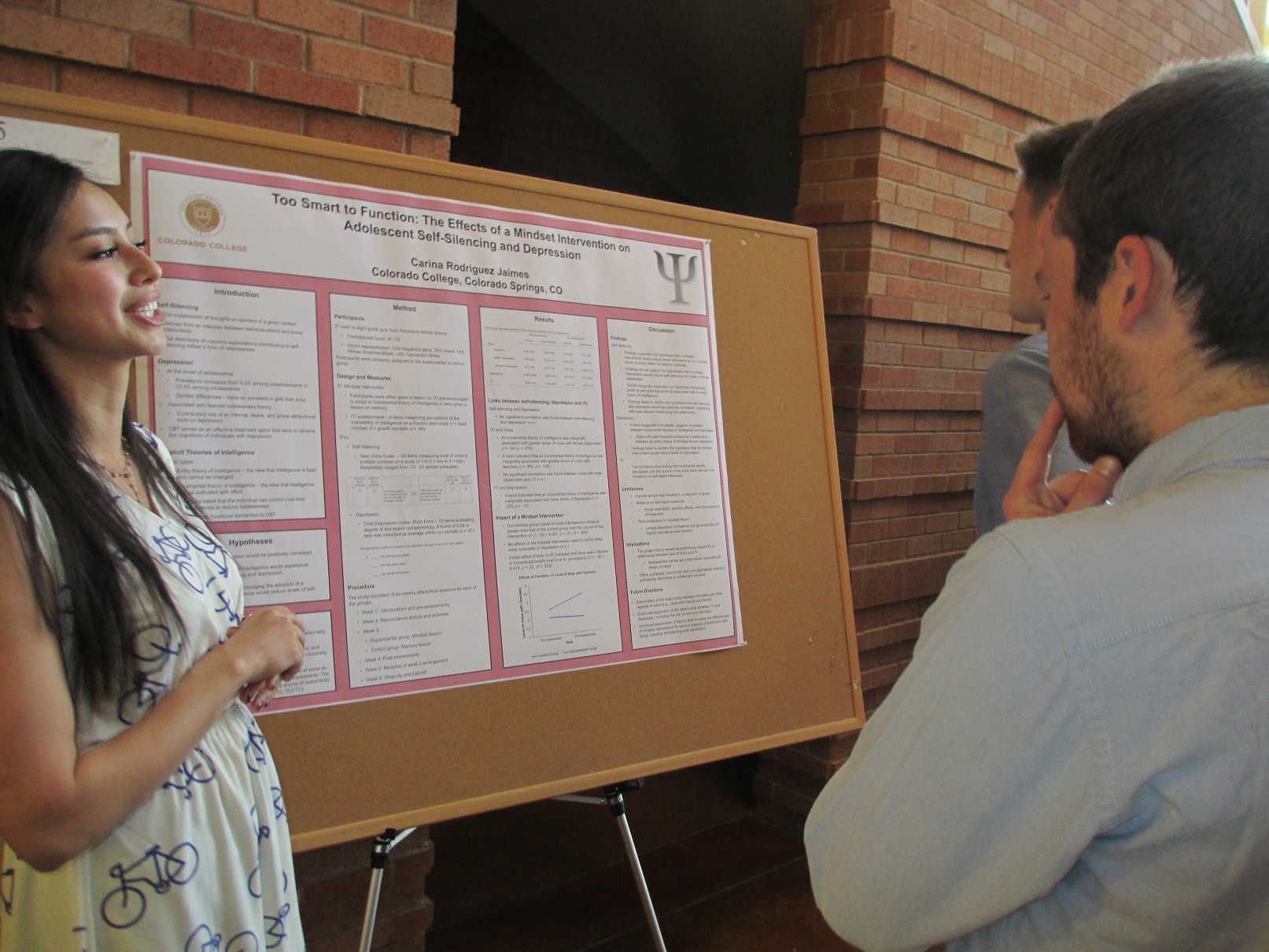 Carina Rodriguez Jaimes
Carina Rodriguez Jaimes
Psychology
Advisor: Tricia Waters
Too Smart to Function:
The Effects of a Mindset Intervention
on Self-Silencing and Depression
Self-silencing and depression are two factors that may contribute to the difficulty faced by many youths upon reaching adolescence. I proposed that an implicit theory of intelligence (ITI) intervention encouraging the adoption of an incremental theory of intelligence would reduce levels of self-silencing and depression among middle school girls by challenging entity self-statements and encouraging growth self-statements. The intervention was structured as a six-week after school program consisting of one, hour long session per week for control and experimental groups. A significant correlation was found between condition and voice with teachers, with the experimental group experiencing greater levels of voice following the intervention. No significant effects were found between other voice subscales and group or between depression and group. These findings suggest that an ITI intervention can increase voice in the school setting but the intervention may need to be generalized beyond the academic domain to have a more widespread impact on adolescent well-being.
 Keli Sherwood
Keli Sherwood
Psychology
Advisor: Jason Weaver
The Effect of Stereotype Threat on Student-Athlete
Self-Handicapping in an Academic Context
Stereotype threat occurs when people perceive themselves as being at risk of confirming a negative stereotype about a group with which they identify. Self-handicapping occurs when individuals anticipate a threat to self-esteem on an upcoming assessment and subsequently withdraw practice effort or claim handicaps to their performance in order to diminish the negative attributions that can be made to their personal abilities if they perform poorly. The current study examined whether student-athletes experiencing stereotype threat claimed self-handicaps prior to an academic assessment more than student-athletes not experiencing stereotype threat. Participants completed a survey in which they had the opportunity to claim self-handicaps prior to taking a math quiz. Results revealed that neither experimental condition nor gender had a significant effect on either self-handicapping scores or math quiz scores. Further research should examine the potential use of claimed self-handicapping in mitigating the effects of stereotype-threat on student-athletes.
 Julia Terman
Julia Terman
Psychology
Advisor: Kristi Erdal
Mental Illness Self-Stigma and Help Seeking Attitudes:
Psychiatric Medication vs. Psychotherapy
This study explored the relationship between mental illness self-stigma (SS) and help seeking attitudes towards psychiatric medication (HSM) versus psychotherapy (HSP). A pilot study (study 1) was conducted to establish reliability of two adapted measures. SS and HS questionnaires were given to 133 participants via MTurk for study 2. A significant negative relationship was found between mental illness self-stigma and psychotherapy seeking attitudes, confirming the original hypothesis. When split by gender, this relationship was significant for men, but did not exist for women. A significant negative relationship between mental illness self-stigma and psychiatric medication seeking attitudes was found for women, but did not exist for men. Psychoeducation and clinicians should target these gender differences to portray psychotherapy as a positive treatment option for men and psychiatric medication as a positive option for women.
 Korbyn Sealy Ukasick
Korbyn Sealy Ukasick
Psychology
Advisor: Bob Jacobs
The Potential for Flow Within the Structure of Closed-Skill Individual Sports
and Open-Skill Team Sports
Flow is an important concept in sports psychology due to its ability to increase performance, enjoyment, and concentration during play. Although flow is possible across all sports, the experience of flow may vary between individual and team sports due to the specific requirements and sport structure present during competition. The present review examined the factors that may make the individual, closed-sport setting (e.g., gymnastics) more conducive to the flow experience than open-skill team sports (e.g., hockey). Self- and team-efficacy; the presence of mindfulness, control, and distraction; the increased presence of routine in individual sports; and the internal and external feedback within each sport were examined as structural and environmental factors potentially altering the experience of the flow state.
 Monica N. H. Weindling
Monica N. H. Weindling
Psychology
Advisor: Kristi Erdal
Implicit Theories of Ability in Youth Athletics
While implicit theory of intelligence (i.e. entity or incremental mindset) has been studied within school settings, no research to date has looked at how the parallel implicit theory of ability may develop in athletics. It is likely that the incremental mindset is equally as beneficial in athletics as it is in academics. Participants were individuals involved in local youth basketball leagues, as 112 youth athletes aged 5-14 completed the Implicit Theory of Ability questionnaire, and 15 coaches completed the Implicit Theory of Ability in Others questionnaire. As predicted, age had a positive relationship with mindset in that older children had more incremental mindset. There was a trend indicating that more competitive players had more incremental theories of ability; however, there was no interaction between the age and level of play on implicit theory of ability. Level of play coached had no effect on coaches' implicit theory of ability in others. While there were limitations due to a cross-sectional design, this study sets the groundwork for future research into how implicit theories of ability may develop in youth athletics, and what may be done to influence this.
 Jessica Wright
Jessica Wright
Psychology
Advisor: Tricia Waters
Problematic Sexual Behaviors in Adults with Intellectual Developmental Disabilities: A Field Study
Abstract: An intellectual developmental disability is defined as a disorder with onset during developmental periods from pre-natal through adolescence, including deficits in both intellectual and adaptive functioning for conceptual, social, and practical domains. Individuals with this disorder are at increased risk of developing problematic deviant sexual behaviors due to both internal and external factors that ultimately hinder the development of moral reasoning. Those with such offenses are often placed in community-based settings that provide 24-hour supervision and treatment. The current field placement examined one such group-home containing four individuals with problematic sexual behaviors, with an in-depth focus on two clients with pedophilic offenses. Etiology and trajectory of the pathologies are discussed, as well as effectiveness and limitations of the group-home setting.
show all / hide all


